[dropcap style=”font-size:100px; color:#992211;”]S[/dropcap]ilence rarely speaks but when it does the effect is potent.
Over the 3 days comprising the 8th, 9th and 10th of April 2015 Thelemites around the world will celebrate the transmission of Liber Al Vegis to Aleister Crowley in a Cairo hotel room. The year was 1904. One hundred and eleven years ago.
His wife Rose had dreamed of something important in the Cairo Museum and directed his attention to an object known as the Stele of Revealing. Its catalogue number was 666, a number with great significance for Crowley, who considered himself to be, among other things, the Great Beast as prophesied in Revelations 666. The stele depicts the Egyptian Goddess Nuit, or Nu, filled with stars and arched above a human priest who is directing fire towards the hawk-headed god Horus seated on a throne. Above the priest and Horus the fire has become a winged fire ball (the god Hadit) flying up towards the ‘heart’ of the goddess.
After seeing the stele on the 7th of April Crowley heard a voice in his hotel room on the 8th. It introduced itself as Aiwass and claimed to be the minister of silence. It dictated to him the first section of Liber Al vel Legis which is the technical name for The Book of The Law. Part one is the voice of Nuit who offers her delights and entreats us to assist in her unveiling.
On the following day Crowley received part two: the voice of Hadit the winged secret flame.
Finally on the 9th in part 3 it is Horus whose voice is heard. The Hawk-headed one makes it plain that he is a god of war and vengeance. In his introduction to the tome Crowley points out that Horus is the ruler of the present Aeon a reign which began in 1904 and will last for 2,000 years.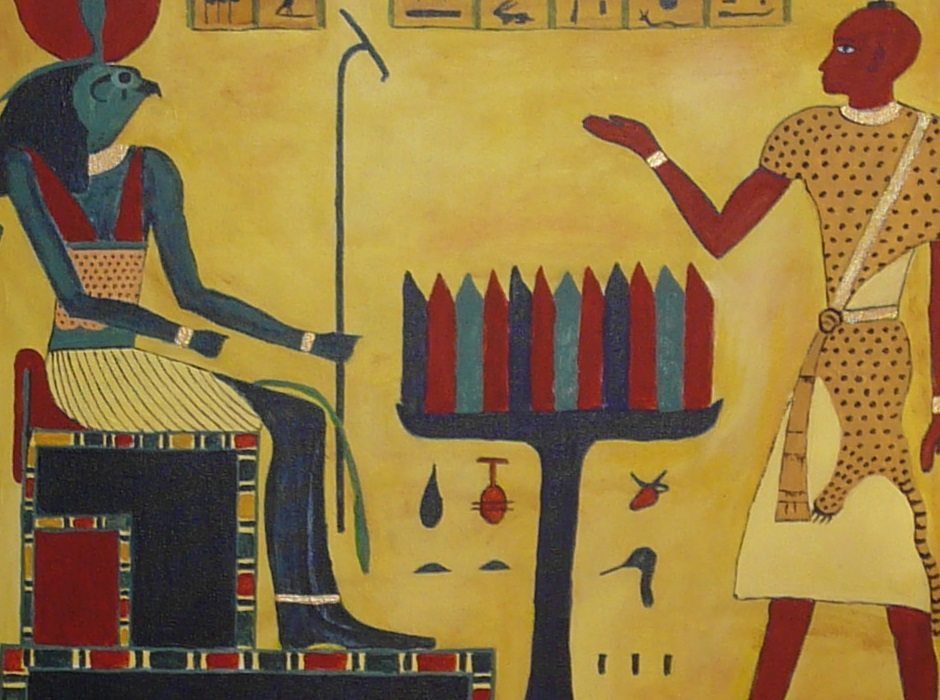
The three participants in this oral play are all represented on the stele of revealing as is a human priest who is referred to by the name Ankh-F-N-Khonsu which translates as ‘a priest of the moon who reflects the rays of the sun’.
Although the voices are of ancient provenance their shared message is evolutionary and their instructions both technical and scientific, if obscure. We, the listeners, are encouraged to explore every possibility that nature, purged of false accretions such as ethics, morality and man-made laws, offers. As if we are each spinning our own strand of the same web. A web which we began long before the dark days of Ancient Egypt and which will not be complete until every possibility has been worked out.
In other words: a total extension of consciousness to embrace all possibilities.
Perhaps the most famous passage in Liber Al is the much quoted and generally misunderstood ‘Do what Thou wilt shall be the whole of the Law’ which is generally considered to be an exhortation to total hedonism and self-satisfaction. From the perspective of silence a different aspect appears. The Grimoire itself advises that ‘spelling is defunct’ and ‘put the stops where ye may’. Freed of the restrictions of spelling and punctuation here is one of many possible interpretations for the traditional Thelemite greeting:
DO WHAT THOU (thou being a combination of the low, middle and high selves. A creature of silence) WILT (whenever the growth/return of Thou is stunted by mundane thought/habitual action it wilts without nourishment and causes effects in doing so) SHALL BE (future imperative. The be or ‘bee’ is, in Egyptian lore, the soul’s companion on its travel through the land of the dead) THE WHOLE (hole – an exit and entrance point) OF THE (thee) LAW (restricted area with finite conditions and also a contact point for the Loa – star beings or spiritual companions).
The whole book is eligible for such semantic/psychological exercises. It also contains cyphers, number games, riddles, spells curses and an instruction to re-arrange the text into a completely different format. There are also unfortunate errors, omissions and obscurities, due to the egotistical nature of its scribe. In the Nuit section where Crowley clearly heard the words ‘the atomic fact of my universality’ and wrote them down in his initial manuscript, what appears in the finished volume is the less potent phrase ‘the omnipresence of my body’. He also added to the initial text from other sources.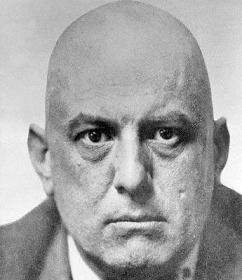
The experience of being a transmitter was a disturbing one for Crowley, who for many years feared that the event had been some kind of trick perpetuated by his wife. He even detested the prose style of Liber Al comparing it unfavourably with his own.
Ahem.
Hoodoo Priest Michael Bertiaux, who claims to have since made his own contact with the discorporate being Aiwass, infers that Crowley was simply a strong-willed individual with tremendous occult potential who bulled his way into a genuine extra-terrestrial or other dimensional contact and then scrawled all over it with his own personality problems. Crowley’s biographer, the late Kenneth Grant, is more charitable but no less rigorous in his examination of Liber Al and Crowley’s part in in its flawed transmission. Grant’s nine volume Typhonian Trilogy stands as the definitive work on the Grimoire, spinning its implications out effortlessly into other dimensions, time stations and incarnations.
Unlike ‘counter-culture’ notables such as John Lennon, Timothy Leary, Jimmy Page, L Ron Hubbard, Kenneth Anger and Alan Moore I was not drawn to the book through an interest in the Master Therion (my own opinion on the man, the myth and the mage has always been closer to Bertiaux than Grant) rather it was my obsession with the works of H P Lovecraft that triggered an affinity with the hidden promise of Liber Al: contact with beings of a praetor human intelligence. I became aware that Grant’s Nu Isis Lodge, an offshoot of Crowley’s official church the OTO, had performed rites and workings based on Lovecraft’s Chtulhu mythos in the nineteen-fifties so I purchased Outer Gateways. Its many references to Liber Al jogged my memory and sure enough at the bottom of a pile of my old books was a dusty copy of the blasphemous tome bought as a curio back in the seventies.
I dusted it off and began to apply the de-coding technique outlined above.
Other techniques are available.
Regarding the Lovecraft connection; many modern occultists are of the opinion that his imaginary Grimoire, the Necronomicon or Book of Dead Names, is a purer and more potent item than Liber Al as, like Bitcoins, it does not exist in a physical reality. It is considered an invisible book of which genuine fragments appear in Lovecraft’s fiction and can only be thoroughly ‘read’ by arcane methods. A disciplined imagination is a wonderful tool.
In 2004 on the hundredth anniversary of The Book of the Law Kenneth Grant called it ‘the log of a time traveller’. Eleven years later it is still, as yet, incomplete. The star traveller is still on its way from here to there and, as Horus plainly states at the start of his fierce explication: THERE IS SUCCESS.

Having completed principal photography on phase one of the Sharks revival SWP is now preparing to edit the One Last Thrill feature documentary. Sharks themselves are ‘dropping a big one’ by releasing a double album Dark Beatles/White Temptations in April 2018.
In his spare time the author kayaks the muddy river Ouse and walks the South Downs which gently enfold his home town of Lewes.



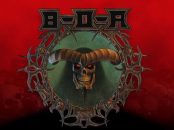
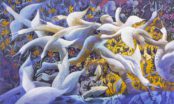


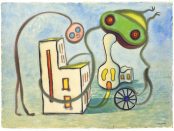



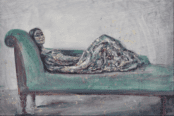








SWP is a living dead who thought he was some kind of god. He is lonely and he will probably go to hell.